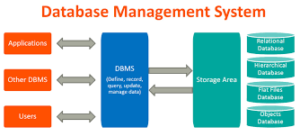Database Management System (DBMS)

Database Management System for Training provides by TechFly, Jodhpur. Here we are discussing DBMS Introduction, Features, Advantages & Course. Database Management System is a very important component.
Database Management System (DBMS) is a database as information stored on a computer that which is used to record, maintain and retrieve data. It is an organized collection of a database. Common database structures are hierarchical, network, relational and object-oriented based & most widely used relational database for web applications.
The database management system can be divided into five major components, they are:
- Hardware
- Software
- Data
- Procedures
- Database Access Language
DBMS Components: Hardware
When we say Hardware, we mean computer, hard disks, I/O channels for data, and any other physical component involved before any data is successfully stored into the memory.
When we run Oracle or MySQL on our personal computer, then our computer’s Hard Disk, our Keyboard using which we type in all the commands, our computer’s RAM, ROM all become a part of the DBMS hardware.
Database Management System Components: Software
This is the main component, as this is the program which controls everything. The DBMS software is more like a wrapper around the physical database, which provides us with an easy-to-use interface to store, access and update data.
The DBMS software is capable of understanding the Database Access Language and interpret it into actual database commands to execute them on the DB.
DBMS Components: Data
Data is that resource, for which DBMS was designed. The motive behind the creation of DBMS was to store and utilize data.
In a typical Database, the user saved Data is present and metadata is stored.
Metadata is data about the data. This is information stored by the DBMS to better understand the data stored in it.
For example: When I store my Name in a database, the DBMS will store when the name was stored in the database, what is the size of the name, is it stored as related data to some other data, or is it independent, all this information is metadata.
DBMS Components: Procedures
Procedures refer to general instructions to use a database management system. This includes procedures to setup and installs a DBMS, To log in and log out of DBMS software, to manage databases, to take backups, generating reports etc.
DBMS Components: Database Access Language
Database Access Language is a simple language designed to write commands to access, insert, update and delete data stored in any database.
A user can write commands in the Database Access Language and submit it to the DBMS for execution, which is then translated and executed by the DBMS.
A user can create new databases, tables, insert data, fetch stored data, update data and delete the data using the access language.
Features of (DBMS)Database Management System:-
1.DBMS to insert, modify/insert/delete data for them and thus it acts as a layer of abstraction from top of the file system.
2.DBMS works as Centralized database & Distributed database.
3.DBMS interacting with a query language which is called structured query language (SQL).
4. Database system optimizes and storage data in fields, records, files or objects.
5.DBMS validates data entered against allowed types & size before storing it.
Advantages of (DBMS)Database Management System:-
1. DBMS protecting confidential & sensitive data.
2. Data backup facility to ensure safe & secured availability of data.
3. Access logs & tables making more easier to stored data in a database, each field having own size, type and a set of range.
4.Formulas such as counting, averaging and summing included in the DBMS, which makes data analysis and presentation easily.
5.DBMS having Performance monitoring and optimization tools for a database.
Home:-https://www.techfly.in/
if you want more info about DBMS then refer to this link :-

